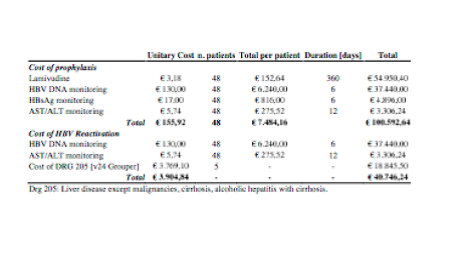LAMIVUDINE FOR PREVENTION OF REACTIVATION IN OCCULT HEPATITIS B IN PATIENTS WITH NON-HODGKIN LYMPHOMA CD20+ UNDERGOING CHEMOTHERAPY : A COST-EFFECTIVE ANALYSIS
(Abstract release date: 05/19/16)
EHA Library. Cerchione C. 06/09/16; 135008; PB2108

Dr. Claudio Cerchione
Contributions
Contributions
Abstract
Abstract: PB2108
Type: Publication Only
Background
Occult HBV infections (OBI) are defined by the persistence of HBV in the liver without serum HBsAg and HBV-DNA. They can represent a life threatening event during immunosuppressive CHT. OBI occur in approximately 18% of HBcAb+ patients. Guidelines suggest surveillance for HBV markers in immunosuppressed patients, in particular in treatment with monoclonal antibodies. In our study, the prevalence of OBI reactivation in NHL, in 498 patients of our centre, was 10.42% in HBcAb+ HBsAb- patients. In this work, a cost-effectiveness analysis regarding the use of Lamivudine for the prevention of reactivation in OBI in patients with NHL undergoing chemotherapy with or without Rituximab was performed. In fact, considering guidelines and literature, universal prophylaxis should have been applied to all HBcAb + HBsAg - patients. A cost-benefit issue arises : is it more cost-effective to treat all the HBcAb + HBsAg - patietns with Lamivudine to prevent the OBI reactivation occurence in a small quote of them, or may it be more effective a “wait and see” protocol?
Aims
Our idea was to perform a cost-effectiveness analysis, comparing the costs of prophylaxis of an eventual HBV reactivation and the “monitoring” approach that was used in our patients based on international guidelines.
Methods
The cost of Lamivudine prophylaxis was calculated in a time interval of 12 months, which encompasses the time of a standard Rituximab-containing regimen and a minimum time of follow-up. It has been noticed that, very often, NHL patients need more than one treatment to obtain remission, and, sometimes, if they do not obtain a CR, undergo to long-term “maintenance” with Rituximab. These patients (HBcAb +) are at high risk of HBV reactivations, due to long periods of immunosuppression.
Results
Nevertheless, even if our calculations underestimated the costs of prophylaxis, the “monitoring approach” resulted cost-effective. Moreover, even though in our series no serious events in terms of morbidity and/or mortality occurred, in other papers a monitoring approach did not guarantee patients survival. These detrimental results could be ascribed to the delayed start of lamivudine treatment if the monitoring is not adequately strict. Also, it has been reported that performing only the transaminase monitoring should not be acceptable to prevent severe reactivations.
Conclusion
Our monitoring approach resulted efficacious probably because of the monthly ALT assay was strictly observed.

Session topic: E-poster
Keyword(s): Cost effectiveness, Hepatitis B virus, Lymphoma
Type: Publication Only
Background
Occult HBV infections (OBI) are defined by the persistence of HBV in the liver without serum HBsAg and HBV-DNA. They can represent a life threatening event during immunosuppressive CHT. OBI occur in approximately 18% of HBcAb+ patients. Guidelines suggest surveillance for HBV markers in immunosuppressed patients, in particular in treatment with monoclonal antibodies. In our study, the prevalence of OBI reactivation in NHL, in 498 patients of our centre, was 10.42% in HBcAb+ HBsAb- patients. In this work, a cost-effectiveness analysis regarding the use of Lamivudine for the prevention of reactivation in OBI in patients with NHL undergoing chemotherapy with or without Rituximab was performed. In fact, considering guidelines and literature, universal prophylaxis should have been applied to all HBcAb + HBsAg - patients. A cost-benefit issue arises : is it more cost-effective to treat all the HBcAb + HBsAg - patietns with Lamivudine to prevent the OBI reactivation occurence in a small quote of them, or may it be more effective a “wait and see” protocol?
Aims
Our idea was to perform a cost-effectiveness analysis, comparing the costs of prophylaxis of an eventual HBV reactivation and the “monitoring” approach that was used in our patients based on international guidelines.
Methods
The cost of Lamivudine prophylaxis was calculated in a time interval of 12 months, which encompasses the time of a standard Rituximab-containing regimen and a minimum time of follow-up. It has been noticed that, very often, NHL patients need more than one treatment to obtain remission, and, sometimes, if they do not obtain a CR, undergo to long-term “maintenance” with Rituximab. These patients (HBcAb +) are at high risk of HBV reactivations, due to long periods of immunosuppression.
Results
Nevertheless, even if our calculations underestimated the costs of prophylaxis, the “monitoring approach” resulted cost-effective. Moreover, even though in our series no serious events in terms of morbidity and/or mortality occurred, in other papers a monitoring approach did not guarantee patients survival. These detrimental results could be ascribed to the delayed start of lamivudine treatment if the monitoring is not adequately strict. Also, it has been reported that performing only the transaminase monitoring should not be acceptable to prevent severe reactivations.
Conclusion
Our monitoring approach resulted efficacious probably because of the monthly ALT assay was strictly observed.

Session topic: E-poster
Keyword(s): Cost effectiveness, Hepatitis B virus, Lymphoma
Abstract: PB2108
Type: Publication Only
Background
Occult HBV infections (OBI) are defined by the persistence of HBV in the liver without serum HBsAg and HBV-DNA. They can represent a life threatening event during immunosuppressive CHT. OBI occur in approximately 18% of HBcAb+ patients. Guidelines suggest surveillance for HBV markers in immunosuppressed patients, in particular in treatment with monoclonal antibodies. In our study, the prevalence of OBI reactivation in NHL, in 498 patients of our centre, was 10.42% in HBcAb+ HBsAb- patients. In this work, a cost-effectiveness analysis regarding the use of Lamivudine for the prevention of reactivation in OBI in patients with NHL undergoing chemotherapy with or without Rituximab was performed. In fact, considering guidelines and literature, universal prophylaxis should have been applied to all HBcAb + HBsAg - patients. A cost-benefit issue arises : is it more cost-effective to treat all the HBcAb + HBsAg - patietns with Lamivudine to prevent the OBI reactivation occurence in a small quote of them, or may it be more effective a “wait and see” protocol?
Aims
Our idea was to perform a cost-effectiveness analysis, comparing the costs of prophylaxis of an eventual HBV reactivation and the “monitoring” approach that was used in our patients based on international guidelines.
Methods
The cost of Lamivudine prophylaxis was calculated in a time interval of 12 months, which encompasses the time of a standard Rituximab-containing regimen and a minimum time of follow-up. It has been noticed that, very often, NHL patients need more than one treatment to obtain remission, and, sometimes, if they do not obtain a CR, undergo to long-term “maintenance” with Rituximab. These patients (HBcAb +) are at high risk of HBV reactivations, due to long periods of immunosuppression.
Results
Nevertheless, even if our calculations underestimated the costs of prophylaxis, the “monitoring approach” resulted cost-effective. Moreover, even though in our series no serious events in terms of morbidity and/or mortality occurred, in other papers a monitoring approach did not guarantee patients survival. These detrimental results could be ascribed to the delayed start of lamivudine treatment if the monitoring is not adequately strict. Also, it has been reported that performing only the transaminase monitoring should not be acceptable to prevent severe reactivations.
Conclusion
Our monitoring approach resulted efficacious probably because of the monthly ALT assay was strictly observed.

Session topic: E-poster
Keyword(s): Cost effectiveness, Hepatitis B virus, Lymphoma
Type: Publication Only
Background
Occult HBV infections (OBI) are defined by the persistence of HBV in the liver without serum HBsAg and HBV-DNA. They can represent a life threatening event during immunosuppressive CHT. OBI occur in approximately 18% of HBcAb+ patients. Guidelines suggest surveillance for HBV markers in immunosuppressed patients, in particular in treatment with monoclonal antibodies. In our study, the prevalence of OBI reactivation in NHL, in 498 patients of our centre, was 10.42% in HBcAb+ HBsAb- patients. In this work, a cost-effectiveness analysis regarding the use of Lamivudine for the prevention of reactivation in OBI in patients with NHL undergoing chemotherapy with or without Rituximab was performed. In fact, considering guidelines and literature, universal prophylaxis should have been applied to all HBcAb + HBsAg - patients. A cost-benefit issue arises : is it more cost-effective to treat all the HBcAb + HBsAg - patietns with Lamivudine to prevent the OBI reactivation occurence in a small quote of them, or may it be more effective a “wait and see” protocol?
Aims
Our idea was to perform a cost-effectiveness analysis, comparing the costs of prophylaxis of an eventual HBV reactivation and the “monitoring” approach that was used in our patients based on international guidelines.
Methods
The cost of Lamivudine prophylaxis was calculated in a time interval of 12 months, which encompasses the time of a standard Rituximab-containing regimen and a minimum time of follow-up. It has been noticed that, very often, NHL patients need more than one treatment to obtain remission, and, sometimes, if they do not obtain a CR, undergo to long-term “maintenance” with Rituximab. These patients (HBcAb +) are at high risk of HBV reactivations, due to long periods of immunosuppression.
Results
Nevertheless, even if our calculations underestimated the costs of prophylaxis, the “monitoring approach” resulted cost-effective. Moreover, even though in our series no serious events in terms of morbidity and/or mortality occurred, in other papers a monitoring approach did not guarantee patients survival. These detrimental results could be ascribed to the delayed start of lamivudine treatment if the monitoring is not adequately strict. Also, it has been reported that performing only the transaminase monitoring should not be acceptable to prevent severe reactivations.
Conclusion
Our monitoring approach resulted efficacious probably because of the monthly ALT assay was strictly observed.

Session topic: E-poster
Keyword(s): Cost effectiveness, Hepatitis B virus, Lymphoma
{{ help_message }}
{{filter}}


